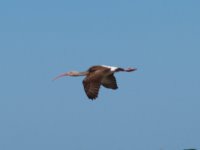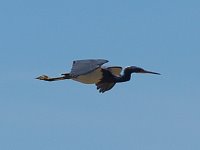First in line is the trip to the Outer Banks in North Carolina, in March of this year. The Outer Banks are a string of very narrow islands out in the Atlantic Ocean, several miles away from the North carolina coast.
It was still rather cold, so there were very few people around. Good.
 The highlight of Cape Hatteras National Seashore is obviously the Cape Hatteras lighthouse. Unfortunately, a few years ago it was moved inland because the coast's erosion was threatening it, so it has become a much less interesting photographic subject. A lighthouse in the middle of a field surrounded by woods is not exactly spectacular. You do hear the ocean in the distance, though.
The highlight of Cape Hatteras National Seashore is obviously the Cape Hatteras lighthouse. Unfortunately, a few years ago it was moved inland because the coast's erosion was threatening it, so it has become a much less interesting photographic subject. A lighthouse in the middle of a field surrounded by woods is not exactly spectacular. You do hear the ocean in the distance, though.Fortunately the local fauna can help give a little more interest to the pictures:

 Not far north of Cape Hatteras, there is another interesting lighthouse, on Bodie Island. There are actually several lighthouses in the area: North Carolina was one of the first states to be colonized, and in the 17th and 18th centuries many routes went by this part of the coast. Most of the lighthouses on these isalnds are well worth a visit.
Not far north of Cape Hatteras, there is another interesting lighthouse, on Bodie Island. There are actually several lighthouses in the area: North Carolina was one of the first states to be colonized, and in the 17th and 18th centuries many routes went by this part of the coast. Most of the lighthouses on these isalnds are well worth a visit.
You may have heard about the "lost colony", the first English colony in America, which was settled in 1587 by 120 people who then vanished without a trace within 3 years. To this day nobody knows exactly what happened to them. The lost colony was situated on Roanoke Island, just a couple of miles north of Bodie Island Lighthouse.
The area is also an important stop in the migratory path of many birds, so with a little patience you can spot some interesting birds. The best place to find migratory birds are two lakes in Pea Island National Wildlife Refuge, which is technically not part of Cape Hatteras NS, even though it lies in the middle of it.
I had just bought the ZD 40-150 and I was hoping to come home with some spectacular bird pictures, but it's actually a lot harder than it seems.
A couple of hard-learned lessons:
- Set the exposure manually, or at least use manual compensation to significantly increase the exposure: unless the bird is pretty much filling the frame, the camera is going to expose for a nice full blue sky. Unfortunately, this means that the bird is going to look like a black spot with no detail whatsoever.
- Use continuous autofocus, follow the bird in the viewfinder (harder than it seems) and keep shooting.
- Take lots and lots of pictures, in the hope that one of them will turn out ok. This is not a situation where you can visualize a picture, take it, and know that you have it. Don't try to finess it. Go for brute force.
- Use a relatively high ISO speed to keep the shutter very fast. Enough shots will end up out of focus anyway, you don't want the others to be motion-blurred.
- Use the longest and brightest lens you can afford. The birds are not going to come there for you.
Unfortunately I learnt these lessons after I came back and looked at the pictures. This is pretty much the best I have (the first is a White Ibis, the second a Blue Heron):



No comments:
Post a Comment